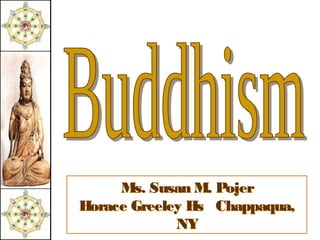
Buddhism
- 1. Ms. Susan M. Pojer Horace Greeley Hs Chappaqua, NY
- 2. Religions of South Asia
- 3. Buddhism in the Subcontinent
- 4. The essence of Buddhism The “middle way of wisdom and compassion.” 2,500 year old tradition. The 3 jewels of Buddhism: Buddha, the teacher. Dharma, the teachings. Sangha, the community.
- 5. Siddhartha Gautama (563-483 BCE) Born in NE India (Nepal). Raised in great luxury to be a king. At 29 he rejected his luxurious life to seek enlightenment and the source of suffering. Lived a strict, ascetic life for 6 yrs. Rejecting this extreme, sat in meditation, and found nirvana. Became “The Enlightened One,” at 35.
- 6. W is the fundamental hat cause of all suffering? Desire! Therefore, extinguish the self, don’t obsess about oneself.
- 7. Four Noble Truths 1. There is suffering in the world. To live is to suffer. (Dukkha) The Buddha found this out when he was young and experienced suffering and death in others.
- 8. Four Noble Truths 2. The cause of suffering is self- centered desire and attachments. (Tanha)
- 9. Four Noble Truths 3. The solution is to eliminate desire and attachments. (Nirvana = “extinction”)
- 10. Four Noble Truths 4. To reach nirvana, one must follow the Eightfold Path.
- 11. Eightfold Path Nirvana The union with the ultimate spiritual reality. Escape from the cycle of rebirth.
- 12. Buddha – 19c Thailand
- 13. Buddha’ s head : 2c Pakistan
- 14. Mandala: Wheel of Life Motif
- 15. Mandala: Wheel of Life Motif
- 16. Buddhist Altar
- 17. Types of Buddhism Therevada Buddhism Mahayana Buddhism Tibetan Buddhism Zen Buddhism
- 18. Theravada Buddhism The oldest school of Buddhism. The “Way of the Elders” or the “Small Vehicle.” Found in southern Asia. The monastic life is the best way to achieve nirvana. Focus on wisdom and meditation. Goal is to become a “Buddha,” or “Enlightened One.” Over 100,000,000 followers today.
- 20. Mahayana Buddhism The “Great Vehicle.” Founded in northern Asia (China, Japan). Buddhism “for the masses.” Seek guidance from Boddhisatvas, wise beings. Goal: Not just individual escape from the wheel, but the salvation of all humanity through self- sacrifice of those enlightened few.
- 22. Seated Boddhisatva – 16c Bhutan
- 23. boddhisatva
- 24. Tibetan Buddhism The “Diamond Vehicle.” [Vajrayana] Developed in Tibet in the 7c CE. A mix of Theravada and Mahayana. Boddhisatvas include Lamas, like the Dalai Lama. The Tibetan Book of the Dead [Bardo Thodol].
- 25. The Dalai Lama
- 26. zen Buddhism The “Meditation School.” Seeks sudden enlightenment [satori] through meditation, arriving at emptiness [sunyata]. Use of meditation masters [Roshi]. Beauty, art, and aesthetics: Gardens. Archery. Tea ceremony. Calligraphy.
- 27. Buddhism in America (1999)
- 28. Distribution of Buddhism Centers in the US, 2001
- 29. 10th Annual western buddhist monastic conference California, 2004
- 30. Relieve Stress & Meditate: Get a M antra ! Ohm...mani...padme...hun g... Hail to the jewel in the lotus!
